A Proposed Index of the Implementation and Maturity of Circular Economy Practices—The Case of the Pulp and Paper Industries of Portugal and Spain
Abstract
1. Introduction
2. State of the Art
2.1. The History and the Concept of Circular Economy
2.2. Practices for Implementation of Circular Economy—Applications in Industry
2.2.1. Eco-Efficiency
2.2.2. Industrial Symbiosis
- Sharing of infrastructures;
- Sharing common service needs;
- By-product exchanges, where one industry uses the waste of another company as raw material.
2.3. Sustainability Indicators in the Evaluation of the Circular Economy
- Eco-efficiency indicators: These indicators are production-based and are measured by the ratio of an input or output to the production of a given industry. Examples include: “Energy consumption per unit of production in the key industrial sector” and “Water consumption per unit of production value”.
- Reuse and industrial symbiosis indicators: The reuse indicators are relevant because the better the performance, the less the extraction and use of new fresh inputs. Examples include: “Reuse ratio of industrial water” and “Recycling rate of industrial waste water”.
3. Materials and Methods
3.1. The Pulp and Paper Industry in Portugal
3.2. Comparative Indicator Developement
- Step 1—Selection of eco-efficiency, and reuse and industrial symbiosis indicators. To assure that the indicators selected were related with the pulp and paper industry, the dimensions and environmental indicators proposed by Su et al. [32] were analyzed and discussed with experts from CELPA. Then, the availability or not of data for a particular indicator was considered to select the final set of indicators.
- Step 2—Computing the indicator values. Secondary data was used to compute the indicators. As the indicators had different units, subsequently, it became necessary to normalize them, that is, to size all categories of indicators so that their values were between 0 and 1. Standardization was achieved by grouping the results of the same category indicators’, and each result was divided by the highest value of the indicator of the same category. The normalized indicator of value 1 represent the worst result, and value 0 represent the best value.
- Step 3—Computing the comparative index. The comparative index is a function of all the indicators selected in step 1. To combine the different indicator’s values, they were combined in a radar chart graph (or spider diagram). Then, the comparative index is a function of the polygon area generated in the graph formed by the different categories of indicators that compose it.
3.3. Data Collection
4. Results
4.1. Results of Eco-Efficiency Indicators
4.1.1. Wood Consumption Indicator
4.1.2. Energy Consumption Indicator
4.1.3. Inefficiency of Water Usage Indicator
- Due to its nature, pulp production uses more fresh water on a specific consumption basis than paper production. This leads to a greater liquid effluents flow than paper production;
- The sector in Portugal produces more pulp in relation to the total production than the sector in Spain;
- The comparison should be fair, so based on the two previous assumptions, data indicating the consumption of pulp and paper should be used in a discriminatory manner, if they are available;
- It was not possible to find separate data for specific effluent flows from the pulp and paper sector in Portugal;
- The sector in Spain has discriminated data for the pulp and paper production.
- The specific rejections of liquid effluents from the sector’s pulp and paper productions in Spain were multiplied by the respective pulp and paper productions in Portugal. In this way, it is possible to calculate the aggregate rejection of liquid effluents (considering that the sector in Spain had the same production levels as in Portugal).
- The result was divided by the total production of the sector in Portugal.
4.1.4. CO2 Emissions Indicator
4.1.5. Solid Waste Deposition on Landfill Indicator
4.2. Results of Reuse and Industrial Symbiosis Indicators
4.2.1. Water Reuse Indicator
4.2.2. Use of Biofuels Indicator
4.2.3. Industrial Symbiosis Indicator
4.3. Results from the Comparative Analysis of the Circular Economy
5. Conclusions
Author Contributions
Funding
Conflicts of Interest
References
- Genovese, A.; Acquaye, A.A.; Figueroa, A.; Koh, S.C.L. Sustainable supply chain management and the transition towards a circular economy: Evidence and some applications. Omega 2017, 66, 344–357. [Google Scholar] [CrossRef]
- Carrillo-Hermosilla, J.; del Río, P.; Könnölä, T. Diversity of eco-innovations: Reflections from selected case studies. J. Clean. Prod. 2010, 18, 1073–1083. [Google Scholar] [CrossRef]
- Preston, F. A Global Redesign? Shaping the Circular Economy. Chatham House, 1 March 2010. [Google Scholar]
- Lazarevic, D.; Valve, H. Narrating expectations for the circular economy: Towards a common and contested European transition. Energy Res. Soc. Sci. 2017, 31, 60–69. [Google Scholar] [CrossRef]
- De Mattos, C.A.; De Albuquerque, T.L.M. Enabling Factors and Strategies for the Transition Toward a Circular Economy (CE). Sustainability 2018, 10, 4628. [Google Scholar] [CrossRef]
- Ellen MacArthur Foundation. Towards the Circular Economy Vol. 1: Economic and Business Rationale for an Accelerated Transition; Ellen MacArthur Foundation: Cowes, UK, 2013. [Google Scholar]
- Abreu, M.C.S.D.; Ceglia, D. On the implementation of a circular economy: The role of institutional capacity-building through industrial symbiosis. Resour. Conserv. Recycl. 2018, 138, 99–109. [Google Scholar] [CrossRef]
- European Comission EUR-Lex—52015DC0614—EN—EUR-Lex. Available online: https://eur-lex.europa.eu/legal-content/en/TXT/?uri=CELEX%3A52015DC0614 (accessed on 17 January 2019).
- Kirchherr, J.; Piscicelli, L.; Bour, R.; Kostense-Smit, E.; Muller, J.; Huibrechtse-Truijens, A.; Hekkert, M. Barriers to the Circular Economy: Evidence From the European Union (EU). Ecol. Econ. 2018, 150, 264–272. [Google Scholar] [CrossRef]
- CELPA—Associação da Indústria Papeleira. Boletim Estatístico Indústria Papeleira Portuguesa 2017; CELPA—Indústria Papeleira Portuguesa: Lisboa, Portugal, 2017; p. 93. [Google Scholar]
- Liu, Y.; Bai, Y. An exploration of firms’ awareness and behavior of developing circular economy: An empirical research in China. Resour. Conserv. Recycl. 2014, 87, 145–152. [Google Scholar] [CrossRef]
- European Comission. 2014/687/UE: Decisão de Execução da Comissão, de 26 de Setembro de 2014 , que Estabelece as Conclusões Sobre as Melhores Técnicas Disponíveis (MTD) para a Produção de Pasta de Papel, Papel e Cartão, nos Termos da Diretiva 2010/75/UE do Parlamento Europeu e do Conselho [Notificada com o Número C(2014) 6750] Texto Relevante para Efeitos do EEE; European Comission: Brussels, Belgium; Luxembourg, 2014; Volume 284. [Google Scholar]
- Avdiushchenko, A. Toward a Circular Economy Regional Monitoring Framework for European Regions: Conceptual Approach. Sustainability 2018, 10, 4398. [Google Scholar] [CrossRef]
- Jawahir, I.S.; Bradley, R. Technological Elements of Circular Economy and the Principles of 6R-Based Closed-loop Material Flow in Sustainable Manufacturing. Procedia CIRP 2016, 40, 103–108. [Google Scholar] [CrossRef]
- Cradle to Cradle Products Innovation Institute About the Institute—Cradle to Cradle Products Innovation Institute. Available online: https://www.c2ccertified.org/about (accessed on 17 January 2019).
- Geng, Y.; Doberstein, B. Developing the circular economy in China: Challenges and opportunities for achieving “leapfrog development”. Int. J. Sustain. Dev. World Ecol. 2008, 15, 231–239. [Google Scholar] [CrossRef]
- Yuan, Z.; Bi, J.; Moriguichi, Y. The Circular Economy: A New Development Strategy in China. J. Ind. Ecol. 2006, 10, 4–8. [Google Scholar] [CrossRef]
- Heshmati, A. A Review of the Circular Economy and Its Implementation; Forschungsinstitut zur Zukunft der Arbeit Institute: IZA: Bonn, Germany, 2015; p. 63. [Google Scholar]
- Guo, J.; Mao, H.; Wang, T. Ecological Industry: A Sustainable Economy Developing Pattern. J. Sustain. Dev. 2010, 3. [Google Scholar] [CrossRef]
- Chertow, M.R.; Ashton, W.S.; Espinosa, J.C. Industrial Symbiosis in Puerto Rico: Environmentally Related Agglomeration Economies. Region. Stud. 2008, 42, 1299–1312. [Google Scholar] [CrossRef]
- Korhonen, J. Four ecosystem principles for an industrial ecosystem. J. Clean. Prod. 2001, 9, 253–259. [Google Scholar] [CrossRef]
- Word Business Council for Sustainable Development. A Eco-Eficiência: Cria Mais Valor Com Menos Impacto; Conselho Empresarial para o Desenvolvimento Sustentável: Lisboa, Portugal, 2000; p. 36. [Google Scholar]
- Chiu, A.S.F.; Ward, J.V.; Massard, G. Introduction to the special issue on Advances in Life-Cycle Approachesto Business and Resource Management in the Asia-Pacific Region. J. Clean. Prod. 2009, 17, 1237–1240. [Google Scholar] [CrossRef]
- Oggioni, G.; Riccardi, R.; Toninelli, R. Eco-efficiency of the world cement industry: A data envelopment analysis. Energy Policy 2011, 39, 2842–2854. [Google Scholar] [CrossRef]
- Park, H.-S.; Behera, S.K. Methodological aspects of applying eco-efficiency indicators to industrial symbiosis networks. J. Clean. Prod. 2014, 64, 478–485. [Google Scholar] [CrossRef]
- Siitonen, S.; Tuomaala, M.; Ahtila, P. Variables affecting energy efficiency and CO2 emissions in the steel industry. Energy Policy 2010, 38, 2477–2485. [Google Scholar] [CrossRef]
- Bauman, Z. Consuming Life; John Wiley & Sons: Hoboken, NJ, USA, 2013; ISBN 978-0-7456-5582-6. [Google Scholar]
- Chertow, M.R. “Uncovering” Industrial Symbiosis. J. Ind. Ecol. 2007, 11, 11–30. [Google Scholar] [CrossRef]
- Felicio, M.C. Proposta de um Indicador Para Monitorar a Evolução da Simbiose Industrial em Parques eco-Industriais Segundo a Perspectiva de Sistemas Dinâmicos; Universidade de São Paulo: São Paulo, Brazil, 2013. [Google Scholar]
- Iacovidou, E.; Velis, C.A.; Purnell, P.; Zwirner, O.; Brown, A.; Hahladakis, J.; Millward-Hopkins, J.; Williams, P.T. Metrics for optimising the multi-dimensional value of resources recovered from waste in a circular economy: A critical review. J. Clean. Prod. 2017, 166, 910–938. [Google Scholar] [CrossRef]
- Elia, V.; Gnoni, M.G.; Tornese, F. Measuring circular economy strategies through index methods: A critical analysis. J. Clean. Prod. 2017, 142, 2741–2751. [Google Scholar] [CrossRef]
- Su, B.; Heshmati, A.; Geng, Y.; Yu, X. A review of the circular economy in China: moving from rhetoric to implementation. J. Clean. Prod. 2013, 42, 215–227. [Google Scholar] [CrossRef]
- APA, A.P.; do, A. APA—Políticas > Resíduos > Desclassificação de Resíduos > Subproduto. Available online: https://www.apambiente.pt/index.php?ref=16&subref=84&sub2ref=957&sub3ref=958 (accessed on 17 January 2019).
- ASPAPEL. Sustainability Report: 2016 Update; Asociación Española de Fabricantes de Pasta, Papel y Cartón: Madrid, Spain, 2016; p. 12. [Google Scholar]
- Vanteddu, G.; Chinnam, R.B.; Yang, K. A performance comparison tool for supply chain management. Int. J. Logist. Syst. Manag. 2006, 2, 342. [Google Scholar] [CrossRef]
- Kleijnen, J.P.C.; Smits, M.T. Performance metrics in supply chain management. J. Oper. Res. Soc. 2003, 54, 507–514. [Google Scholar] [CrossRef]
- Wiedmann, T.O.; Lenzen, M.; Barrett, J.R. Companies on the Scale. J. Ind. Ecol. 2009, 13, 361–383. [Google Scholar] [CrossRef]
- Pereira, C.P.; Paes, D.P.; Prata, D.M.; Monteiro, L.P. Desenvolvimento de Índice de Comparação de Ecoeficiência a partir de Ecoindicadores. Sistemas Gestão 2014, 9, 168–180. [Google Scholar] [CrossRef]
- Zhou, Z.; Chen, X.; Xiao, X. On Evaluation Model of Circular Economy for Iron and Steel Enterprise Based on Support Vector Machines with Heuristic Algorithm for Tuning Hyper-parameters. Appl. Math. Inf. Sci. 2013, 7, 2215–2223. [Google Scholar] [CrossRef]
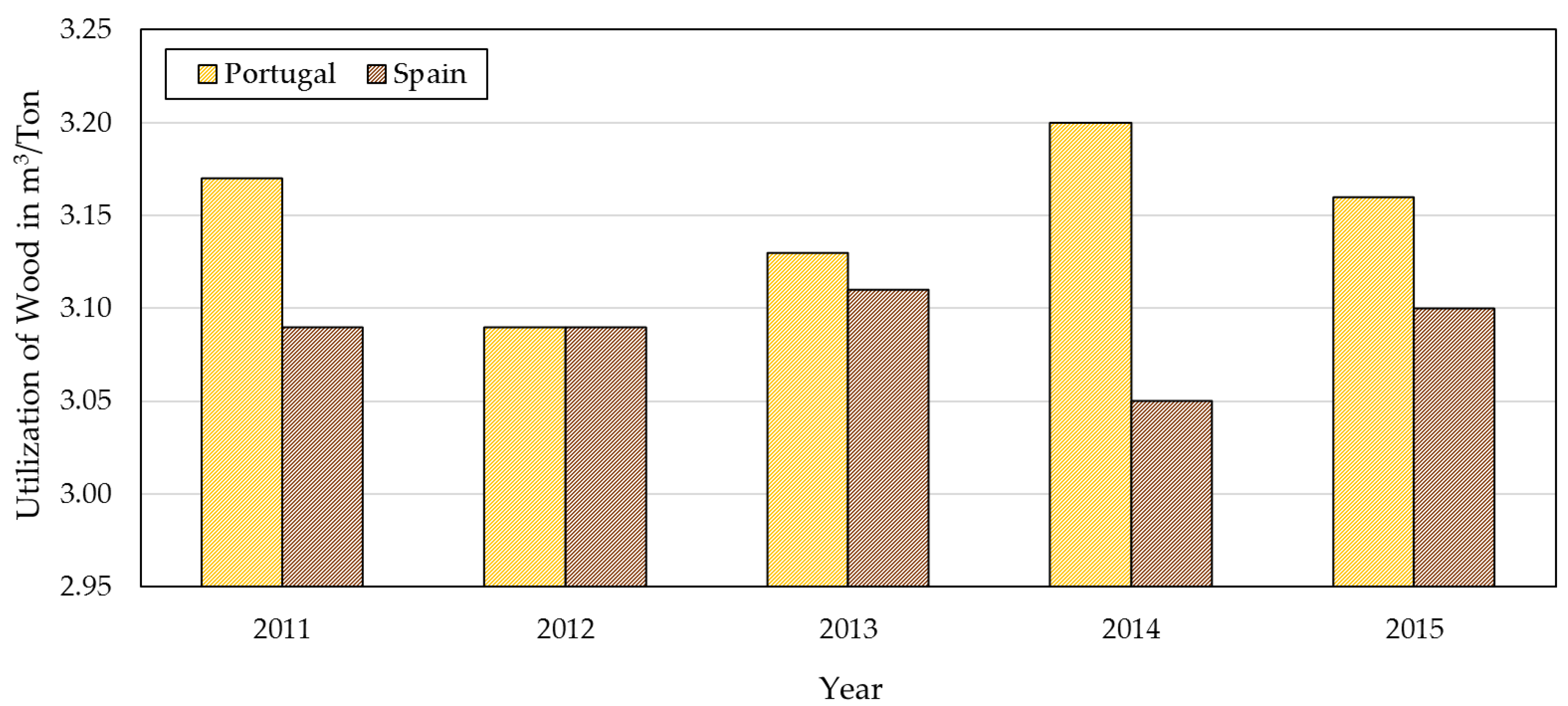

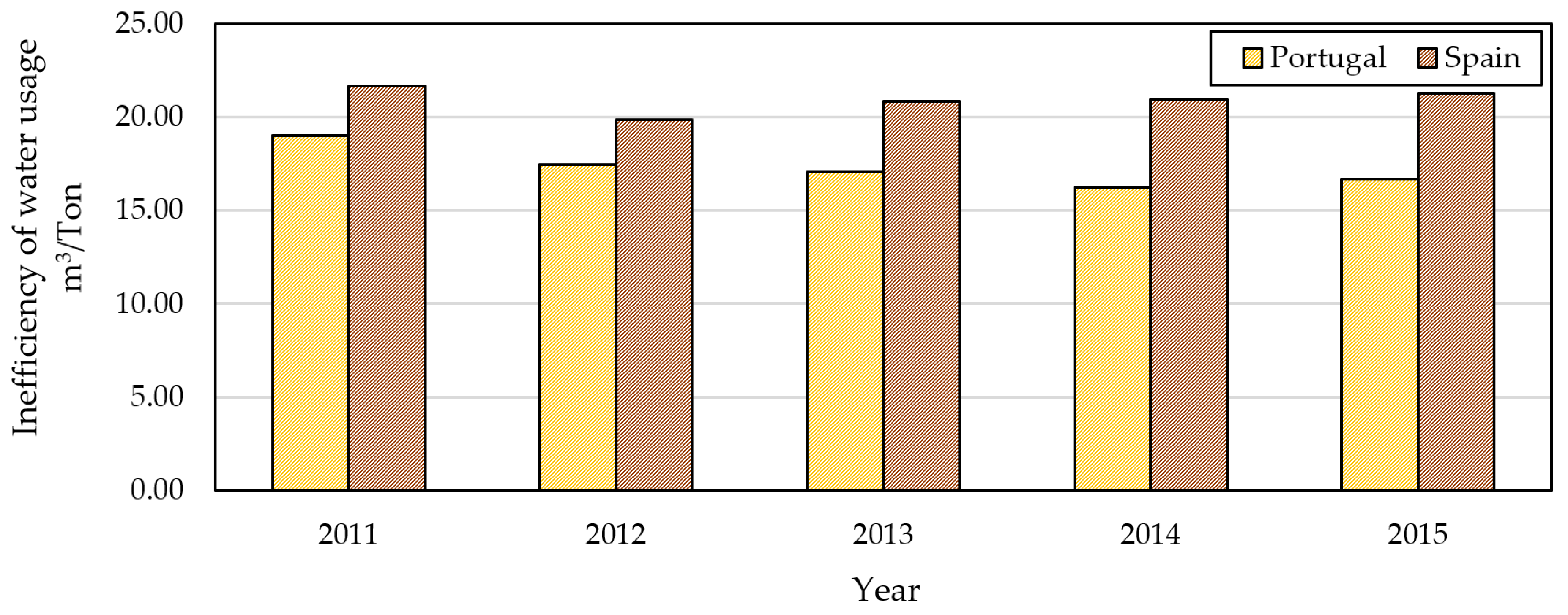

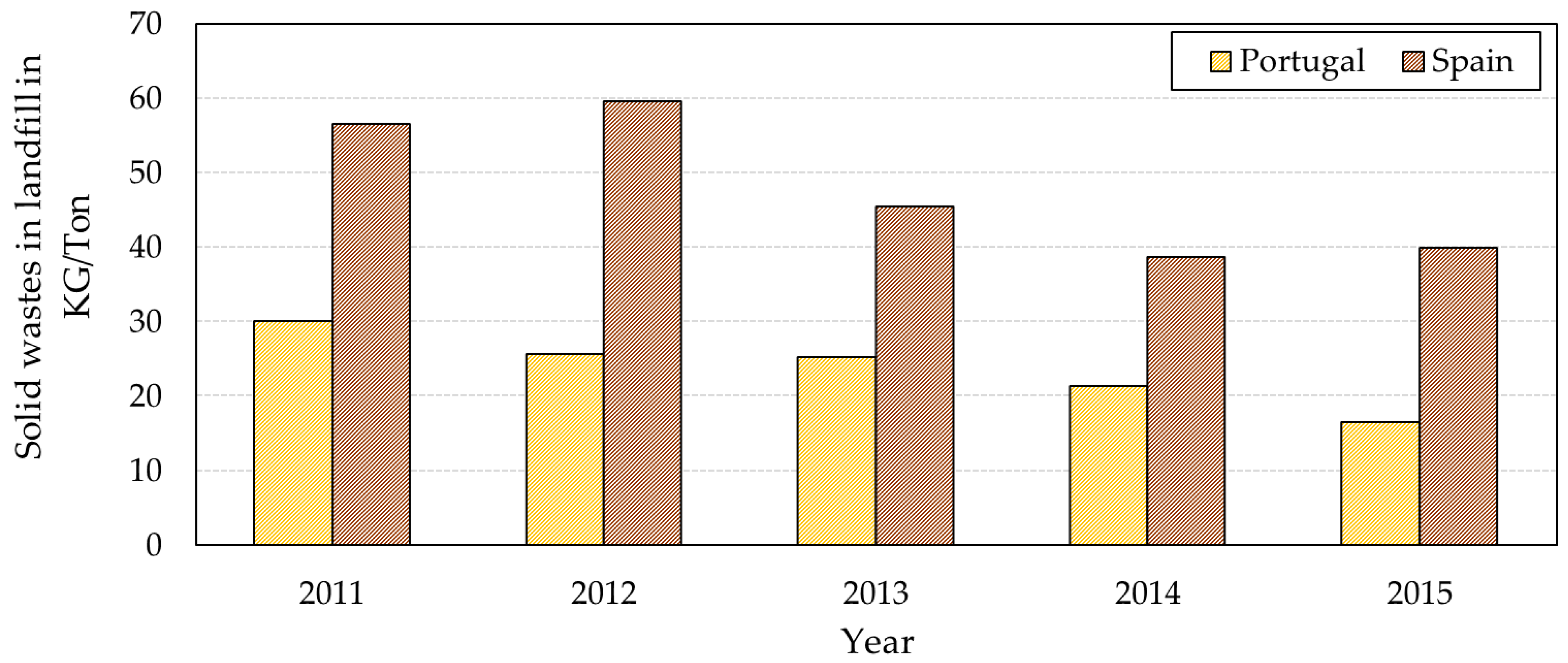
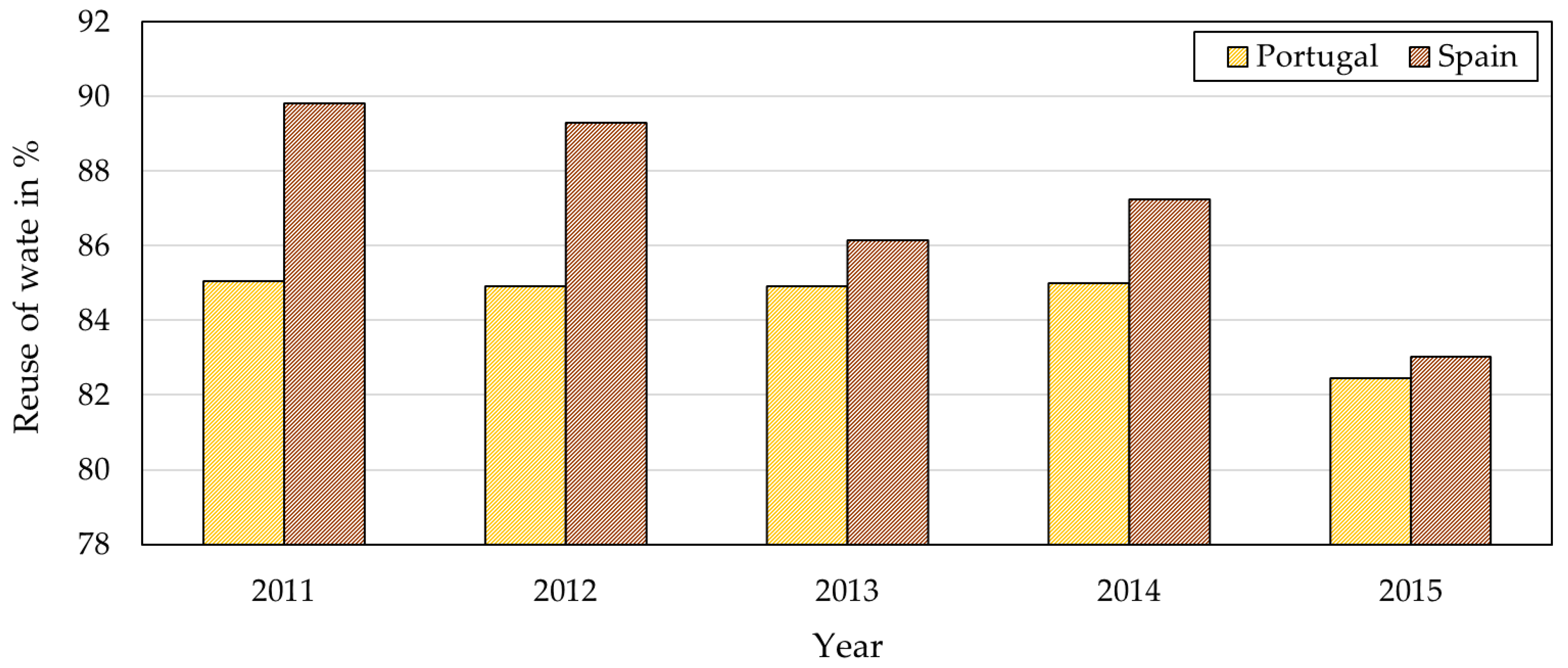

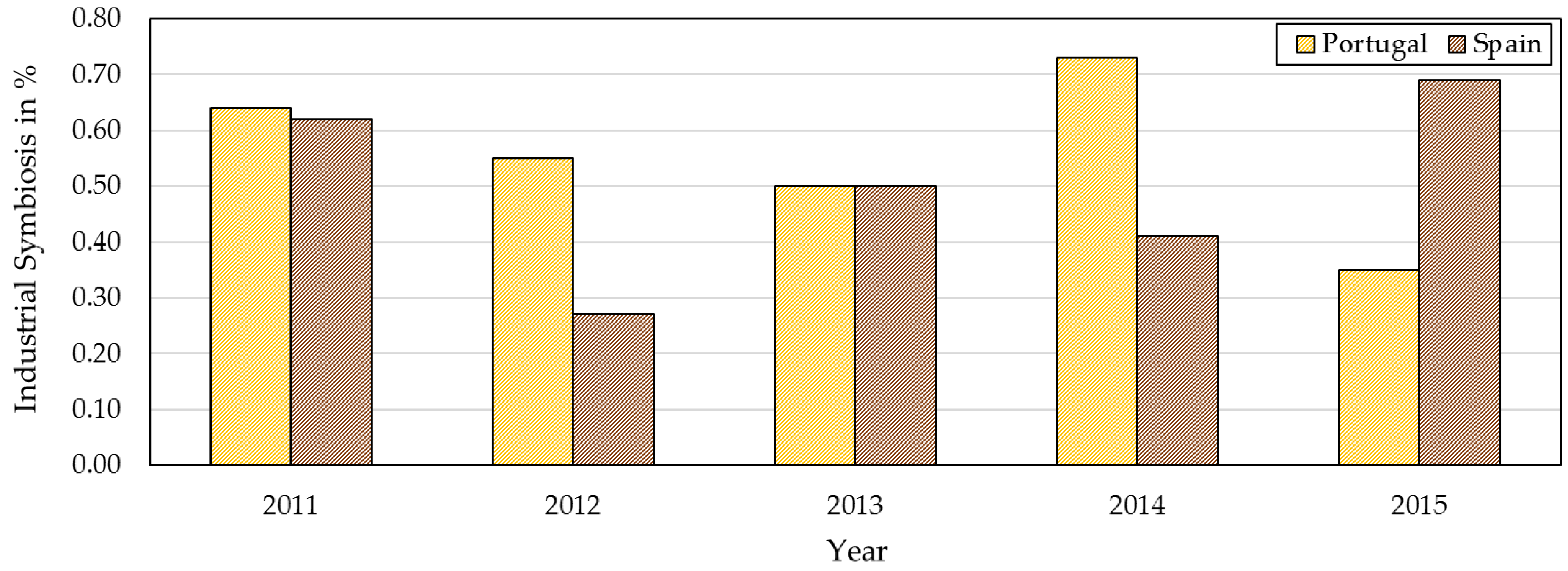


| Category | Environmental Variable | Economic Variable | Indicator | Units |
|---|---|---|---|---|
| Resource utilization | Wood consumption | Pulp production | Wood consumption per ton of produced pulp | m3/Ton |
| Energy consumption | Pulp and paper production | Energy consumption per ton of produced pulp and paper | GJ/Ton | |
| Pollution control | CO2 Emission | Pulp and paper production | CO2 emissions per ton of produced pulp and paper | Ton/Ton |
| Inefficiency of water usage | Pulp and paper production | Residual water rejection per ton of produced pulp and paper | m3/Ton | |
| Waste disposal in landfill | Pulp and paper production | Waste disposal in landfill per ton of produced pulp and paper | kg/Ton |
| Category | Environmental Variable | Indicator | Units |
|---|---|---|---|
| Resource utilization/Reuse | Water | Water reuse rate | % |
| Wood/Energy | Use of biofuels rate | % |
| Indicator | Specific Data |
|---|---|
| Wood consumption | - Total of wood consumption - Pulp production |
| Energy consumption | - Total of electric power consumption - Total production of pulp and paper |
| Inefficiency of water usage | - Liquid effluents rejection - Total production of pulp and paper |
| CO2 Emissions | - CO2 Emissions - Total production of pulp and paper |
| Solid waste deposition in landfill | - Solid waste deposition in landfill - Total production of pulp and paper |
| Water reuse | - Total water captation - Total production of pulp and paper |
| Industrial symbiosis | - Solid waste destination - Total waste production |
© 2019 by the authors. Licensee MDPI, Basel, Switzerland. This article is an open access article distributed under the terms and conditions of the Creative Commons Attribution (CC BY) license (http://creativecommons.org/licenses/by/4.0/).
Share and Cite
Ferreira, I.d.A.; de Castro Fraga, M.; Godina, R.; Souto Barreiros, M.; Carvalho, H. A Proposed Index of the Implementation and Maturity of Circular Economy Practices—The Case of the Pulp and Paper Industries of Portugal and Spain. Sustainability 2019, 11, 1722. https://doi.org/10.3390/su11061722
Ferreira IdA, de Castro Fraga M, Godina R, Souto Barreiros M, Carvalho H. A Proposed Index of the Implementation and Maturity of Circular Economy Practices—The Case of the Pulp and Paper Industries of Portugal and Spain. Sustainability. 2019; 11(6):1722. https://doi.org/10.3390/su11061722
Chicago/Turabian StyleFerreira, Inês de Abreu, Manuel de Castro Fraga, Radu Godina, Marta Souto Barreiros, and Helena Carvalho. 2019. "A Proposed Index of the Implementation and Maturity of Circular Economy Practices—The Case of the Pulp and Paper Industries of Portugal and Spain" Sustainability 11, no. 6: 1722. https://doi.org/10.3390/su11061722
APA StyleFerreira, I. d. A., de Castro Fraga, M., Godina, R., Souto Barreiros, M., & Carvalho, H. (2019). A Proposed Index of the Implementation and Maturity of Circular Economy Practices—The Case of the Pulp and Paper Industries of Portugal and Spain. Sustainability, 11(6), 1722. https://doi.org/10.3390/su11061722







